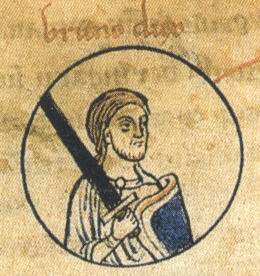Battle of Luneberg Heath
The Battle of Lüneburg Heath (also called the Battle of Ebstorf) was a conflict between the army of King Louis III of France and the Norse Great Heathen Army fought on 2 February 880 AD, at Lüneburg Heath in Saxony.
Following defeat by Alfred the Great at the Battle of Edington,[1] the Norse Great Heathen Army moved from England to pillage Saxony.[2] The army of Louis met the Norsemen at Lüneburg Heath. The Saxons were routed in a snowstorm, with the army being destroyed or captured.
Known combatants include Marquard of Hildesheim, Theodoric of Ninden,[3] Lothar I, Count of Stade, an unidentified count named " Bardonum"[4] and Bruno, Duke of East Saxony[5] who according to the chronicles, Annales Fuldenses[6] and the Gesta Francorum[7] drowned in a river during the Saxon retreat. Those killed were recognized by the Catholic Church as the Martyrs of Ebsdorf, who's feast day is 2 February.
The Norse army were subsequently defeated at the Battle of Thimeon latter that month and finally checked at the Battle of Saucourt.
References
- ↑ Martyrs of Ebsdorf at catholic.org.
- ↑ Tony Jaques, Dictionary of Battles and Sieges: A-E,(Greenwood Publishing Group, 2007) page 324.
- ↑ Martyrs of Ebsdorf at sqpn.com.
- ↑ Gesta Francorum
- ↑ Chronica sancti Pantaleonis
- ↑ Timothy Reuter(trans.) The Annals of Fulda. (Manchester Medieval series, Ninth-Century Histories, Volume II.) Manchester: Manchester University Press, 1992.
- ↑ Bruno, son of Liudolf, died in one of two battles (one at the river Scheldt and one in Saxony) which are reported separately in the Annales Fuldenses. The Gesta Francorum lists "Bardonum…alterum Bardonum [et] tertium Bardonum" as three of the twelve counts who were killed fighting the Danes in 880[120]. The other two counts named "Bardo" or "Bruno" have not been identified.

